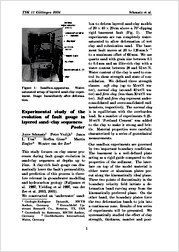Experimental study of the evolution of fault gouge in layered sand–clay sequences
2006Universitätsverlag Göttingen
Sammelband- / Konferenzbeitrag
Verlagsversion
Deutsch
Schmatz, Joyce; Vrolijk, Peter; Urai, Janos L.; Giese, Steffen; Ziegler, Martin; Zee, Wouter van der, 2006: Experimental study of the evolution of fault gouge in layered sand–clay sequences. In: Philipp, S.; Leiss, B; Vollbrecht, A.; Tanner, D.; Gudmundsson, A. (eds.): 11. Symposium "Tektonik, Struktur- und Kristallingeologie"; 2006, Univ.-Verl. Göttingen, p. 191 - 194., , DOI: 10.23689/fidgeo-1890.
 |
Dokument öffnen: |
This study focuses on clay smear processes
during fault gouge evolution in
sand-clay sequences at depths up to
2 km. A clay-rich fault gouge can dramatically
lower the fault’s permeability,
and prediction of this process is therefore
relevant in groundwater modelling
and hydrocarbon geology (Fulljames et
al. 1997, Yielding et al 1997, van der
Zee et al. 2003, 2005).
We constructed an ‘underwater’ sandbox
to deform layered sand-clay models
of 20 × 40 × 20 cm above a 70°-dipping
rigid basement fault. The
experiments are run completely watersaturated
to allow deformation of wet clay and cohesionless sand. The basement
fault moves at 20 to 120mmh−1
to a maximum offset of 60 mm. We use
quartz sand with grain size between 0.1
to 0.4mm and an illite-rich clay with a
water content between 28 and 55 wt.%.
Water content of the clay is used to control
its shear strength and state of consolidation...

